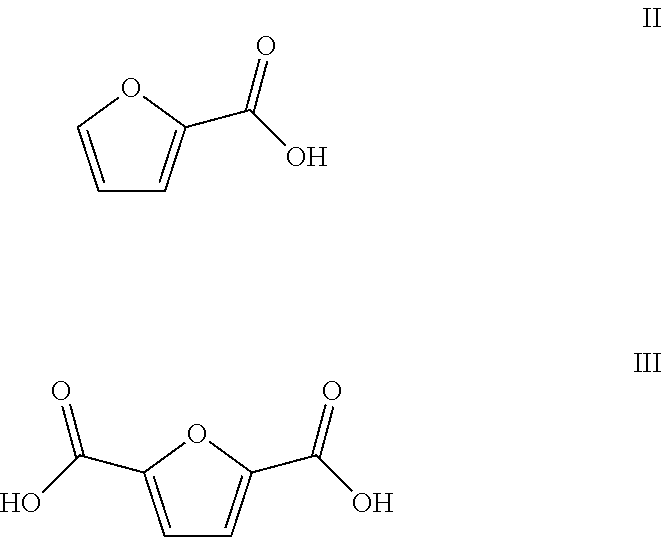Method of producing furan carboxylates from aldaric acids by using solid heterogeneous catalyst
a technology of aldaric acid and catalyst, which is applied in the direction of catalyst activation/preparation, organic compound/hydride/coordination complex catalyst, physical/chemical process catalyst, etc., can solve the problems of limited process scale, limited process scalability, and damage to the environment, so as to reduce the production of considerable amounts of toxic waste and short reaction time of the process
- Summary
- Abstract
- Description
- Claims
- Application Information
AI Technical Summary
Benefits of technology
Problems solved by technology
Method used
Image
Examples
example 1
[0058]The general method was used, with a commercial catalyst phenyl sulfonic acid ethyl sulfide silica and 1-butanol as solvent. The reaction time was 30 min and reaction temperature was 230° C. After the reaction the solid fraction was removed by filtration, and the liquid fraction was concentrated in a rotary evaporator. The evaporated residue was purified with flash column chromatography (30% ethyl acetate in hexane) with silica gel 60. Following products were obtained: Compound IV (0.43 g) and a mixture of compounds V and VI (0.10 g).
[0059]Compound IV was analysed with NMR and FT-IR to give following: 1H NMR (500 MHz, DMSO-d6): δ=7.41 (s, 2H, CH×2), 4.29 (t, 4H, J=6.56 Hz, CH2×2), 1.70-1.64 (m, 4H, CH2×2), 1.42-1.35 (m, 4H, CH2×2), 0.92 (t, 6H, J=8.42 Hz, CH3×2); 13C NMR (125.8 MHz, DMSO-d6): δ=157.5, 146.2, 119.0, 65.0, 30.1, 18.6, 13.6; IR (cm−1) v: 3118 (small), 2958 (medium), 2933, 2871, 1723 (large C═O), 1575, 1267, 1150, 817.
example 2
Phenyl Sulfonic Acid Ethyl Sulphide Silica
[0060]The general method was repeated using a commercial catalyst, phenyl sulfonic acid ethyl sulfide silica, and 1-butanol as solvent. The conditions and the obtained reaction products are given in Table 2.
[0061]
TABLE 2ReactionconditionsYield IIYield IVYield IIIYield VII Entry T (° C.) t (h)2.120045.24.32.22300.51.823.80.95.92.323010.324.6211.52.423043.425.23.924.5
[0062]The general method was repeated with commercial catalyst phenyl sulfonic acid ethyl sulfide silica and 1-butanol as solvent. Reaction conditions were 230° C. and 1 hour reaction time, varying the catalyst quantity. The conditions and the obtained reaction products are given in Table 3.
[0063]
TABLE 3Yield IIYield IVYield IIIYield VII Entry Catalyst quantity (g)3.10.50.712.40.52.43.210.324.6211.53.323.119.41.57.9
example 3
Sulfonic Acid Functionalised Silica MCM-41
[0064]Preparation of sulfonic acid functionalised silica catalyst: Calcinated MCM-41 silica (2.0 g) was mixed with toluene (60 ml) and mercaptyl trimethoxysilane (2.0 ml) and the reaction was refluxed for 24 hours. Solids were filtered, washed with methanol, and dried in a vacuum oven. The resulting functionalised silica was mixed with 30% hydrogen peroxide (40 ml) for 24 hours at room temperature. Solids were filtered and washed with methanol and dried in a vacuum oven.
[0065]The general method was repeated with sulfonic acid functionalised silica catalyst (prepared as described above) and 1-butanol as solvent. The conditions and the obtained reaction products are given in Table 4.
[0066]
TABLE 4Yield IIYield IVYield IIIYield VII EntryReaction conditions T (° C.) t (h)4.120043.30.44.223021.112.03.118.6
PUM
| Property | Measurement | Unit |
|---|---|---|
| temperature | aaaaa | aaaaa |
| temperature | aaaaa | aaaaa |
| reaction time | aaaaa | aaaaa |
Abstract
Description
Claims
Application Information
 Login to View More
Login to View More - R&D
- Intellectual Property
- Life Sciences
- Materials
- Tech Scout
- Unparalleled Data Quality
- Higher Quality Content
- 60% Fewer Hallucinations
Browse by: Latest US Patents, China's latest patents, Technical Efficacy Thesaurus, Application Domain, Technology Topic, Popular Technical Reports.
© 2025 PatSnap. All rights reserved.Legal|Privacy policy|Modern Slavery Act Transparency Statement|Sitemap|About US| Contact US: help@patsnap.com



